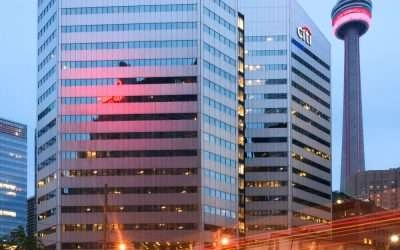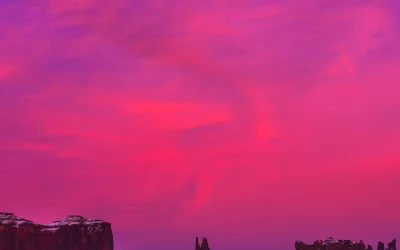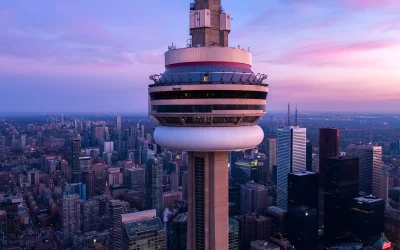Cityscapes can be some of the most challenging and rewarding photography subjects there are. There are so many elements to capture and weave together into a successful photograph.
Here are 10 urban photography tips for taking great cityscape photos!
But first:
What are Cityscapes?

A Cityscape is a type of photograph of a city or urban area. Cityscapes typically feature tall buildings, dense streetscapes, and a variety of other man-made features. They may also include natural features but must be in reference to an urban environment. The term borrows from the word landscapes, where land is replaced by city.
Now on to the list:
Get Up Early for Urban Photography
If you want to avoid the crowds and capture the city in its quietest moments, you’ll need to get up early. Head out before dawn and you’ll be rewarded with some of the most peaceful and atmospheric shots of the day.
The summer months are especially great for city photography because the days are so long. If you are willing to get up ridiculously early it can really pay off. Set your alarm for 4:00 am and bring a bucket of coffee along for your journey. It will pay off!
As a photographer myself, I find the summer months are my busiest times of the year. I’ll work very long days to jam as many projects as possible into this time. I am also Canadian so our summer can be pretty short.
Shoot During the Golden Hour
Golden hour is that magical time just after sunrise or just before sunset when the natural light from the sun is soft, warm, and incredibly flattering. This is one of the best times of day to take photos, especially street photography.
As you might be aware an urban photographer, as with most photographers will want to work within the best times of day with the best light.
However, street photographers might shoot at busier times of the day. Especially if the goal is to photograph people. There are no hard rules to photography, so do whatever you want.
Use Leading Lines for Composition
Leading lines are a powerful compositional tool that can help to give structure and depth to your photo. Look for roads, railways, bridges, or any other linear features that can lead the eye into the frame, and use them to your advantage.
Cityscape photographers understand that photos of cities might be difficult to interpret if they aren’t done correctly. Leading lines are a great way to make your images easily understandable.
Get Outside of the Downtown Core
It is easy to think that heading downtown for cityscapes is the best method to get great photos of the skyline, but that is not really the case.
If you want a clear view of the skyline, it’s better to go outside of the downtown urban environment. The reason is that downtowns are usually so dense that getting a good shot is impossible.
Look around the downtown perimeter for fantastic shots. Parks, waterways, and parking lots are all excellent options.
That is unless you can:
Find a High Vantage Point
Cities are full of tall buildings, so make use of them! Go to the top of a skyscraper or find a rooftop bar with a great view, and you’ll be able to capture a unique perspective of the cityscape.
If you have a drone, you can take great cityscapes from an aerial perspective. Make sure to not just point the drone camera down though as horizontal shots can create some dramatic shots from the sky.
In dense urban areas, it can be hard to find unobscured views of the skyline. Height is almost always the solution, along with distance.
There is however another trick that urban photographers know. I’ll talk more about that later.
Related: A Comprehensive Guide to Drone Photography in Toronto: Everything You Need to Know
Capture Reflections
Reflections can add a touch of magic to cityscape photos. Look for puddles, ponds, lakes, or any other bodies of water that can reflect the cityscape back at you, and use them to create stunningly surreal shots.
As an added tip, consider using a circular polarizing filter to control reflections. With a turn of the filter, you can control the level of reflection from almost none to full-on.
Urban photography can be challenging but the opportunities available for great subject matter are endless. Look up and down, you would be surprised at what you can find.
Experiment with Long Exposures
Long-exposure photography is a great way to capture the hustle and bustle of city life. By using a slow shutter speed, you can blur moving objects such as cars or people, giving your photos a sense of movement and energy.
Shooting urban photography with long exposures can be tricky as there are often a lot of moving objects and bright lights. Try using a tripod and shooting in manual mode to get the best results.
Long exposures really allow us as photographers to get interesting images. It is one of the greatest tricks of photography to be able to manipulate time. It is the only artform really able to do it effectively in my opinion.
Shoot during the Blue Hour
Blue hour is that time just after sunset or just before sunrise when the sky is filled with beautiful blue light. This is an ideal time for city photography as it can give your photos an ethereal quality.
The fact is that most of the best night photography is actually taken during the blue hour. This is for three reasons:
- A big issue with shooting at night is that it’s hard to get a good exposure because it’s often too dark and you lose detail.
- For night shots, you can take shorter exposures to make the image darker. For brighter images, you can take longer exposures.
- And finally, because city pictures and urban landscapes just look better at this time of day.
From my own experience, the blue hour really is the best time to photograph architecture. Photography is just magical at this time of time.
Use Light Trails
Light trails are another great way to add a sense of movement and energy to your cityscape photos. You will want to find a busy roadway in the evening, with fast-moving vehicles. To capture them, simply set up your camera on a tripod and expose it for a long period of time (several seconds or minutes). The motion blur of the lights will create trials of light across the frame.
The slower the shutter speed the more trails you will get. And the larger the aperture the thicker the lines will be. An aperture of f8 to f11 is usually the sweet spot. Make sure your exposure is long enough so the cars disappear and just the lights are visible.
I use light trails quite a bit for my architectural photography. If you do it right they can really create a dynamic image.
The movement of vehicles provides for some intriguing photographs in city settings. Street photos, and more importantly urban settings, should appear to be active. Light trails are a simple method to add drama to a city landscape.
Look for Water in Urban Environments
Water can add a sense of tranquility to cityscape photos, so make sure you include it in your shots if possible. Look for rivers, canals, or any other bodies of water, and use them to add a calming counterpoint to the hustle and bustle of the city.
Most photographers are aware that most cities are near a body of water. It might be an ocean, lake, or river, but the finest views of the city are almost always nearby.
Cityscapes are a challenging but rewarding subject for photographers. They offer a unique perspective of the world and can be used to capture the hustle and bustle of city life. In this article, we’ve provided 10 techniques for taking great cityscape photos. So if you’re looking to improve your city photography skills, make sure to give them a try!








0 Comments